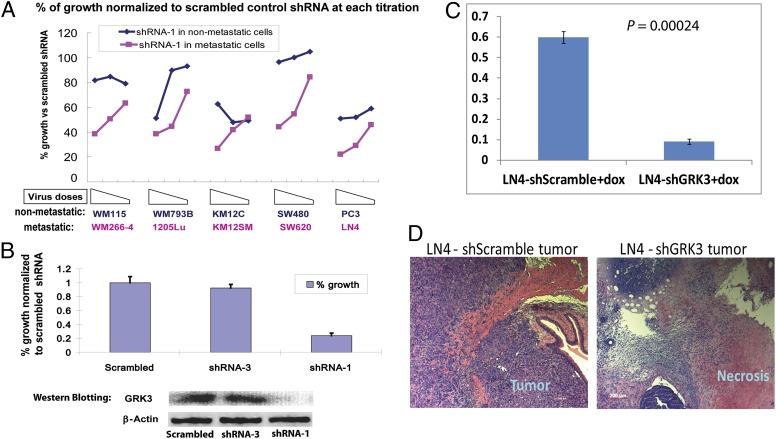Fig. 2.
GRK3 was essential for survival and proliferation of human metastatic cells. (A) GRK3 shRNA-1 preferentially inhibited metastatic cells in culture. Shown on the x axis is three doses of GRK3 shRNA-1 viruses on five pairs of poorly metastatic cell lines (blue) and metastatic lines (pink). Shown on the y axis is the percentage of cell survival and growth normalized to scrambled control shRNA at each titration for each cell line. The three virus titrations were with twofold decrement from left to right. In the absence of puromycin selection, the effects were caused merely by expression of shRNA. (B) GRK3 down-regulation by its shRNAs correlated with inhibition of LN4 cells in vitro. Three LN4 cell lines with Tet-On inducible shRNAs were treated with doxycycline (0.8 µg/mL) for 3 d before being lysed for Western blotting. In a parallel experiment, effects of induced shRNAs on cell survival and proliferation were assessed by Alamar blue at day 5. Shown on the y axis is the average percentage of cell survival and growth from triplicate experiments. Error bars refer to SD. (C) GRK3 is essential for metastatic LN4 cell in vivo. Two LN4 derived lines with doxycycline-inducible shRNAs were injected into prostates of two cohorts of ICR/SCID mice. Two weeks later, shRNAs were induced daily with doxycycline (dox) for an additional 4 wk, at which time the mice were killed. Shown on the y axis are final weights of prostates from LN4 cells expressing doxycycline-induced scrambled control shRNA (Left) or GRK3-shRNA-1 (Right). P values were calculated by using Student t test, and error bars refer to SEM. (D) Representative H&E staining for prostate tumors from LN4 cells expressing doxycycline-inducible shRNAs.

